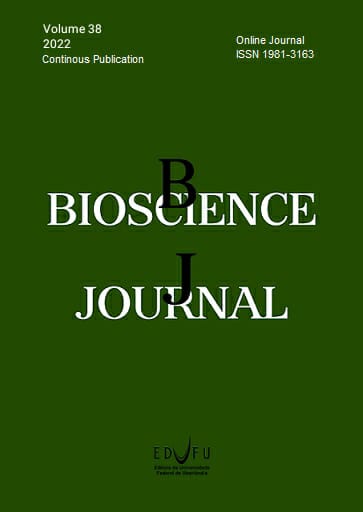Growth of Schizolobium parahyba var. amazonicum seedlings by strains of Trichoderma spp. under boron rates
DOI:
https://doi.org/10.14393/BJ-v38n0a2022-53876Keywords:
firetree, Phytotoxicity, Tolerance, Trichoderma asperellum, Trichoderma harzianum.Abstract
Brazil has many important native species, which includes Schizolobium parahyba var. amazonicum (Huber ex Ducke) Barneby, however, the growth of this species is inhibited in soils with low boron contents, or excess boron, which causes phytotoxicity. Applications of strains of Trichoderma spp. increase the plants' tolerance to abiotic stresses, including tolerance to low or excess levels of nutrients such as boron (B). Thus, the objective of this work was to evaluate plant development and the effect of strains of Trichoderma spp. in Schizolobium parahyba var. amazonicum seedlings grown under different boron rates. A randomized block experimental design was used, with a 4×5 factorial scheme, consisting of 4 strains of Trichoderma spp. and 5 B rates (0, 0.5, 1.0, 1.5, and 2.0 mg dm-3), with seven replications, in greenhouse. Plant height, stem diameter, fresh and dry mass, leaf, stem and total were evaluated at 120 days after emergence. The stains of Trichoderma spp. and B rates presented significant interaction for all evaluated variables, decreasing phytotoxicity. The strain IBLF006WP (T. harzianum) showed a higher capacity of increasing the plants' tolerance to boron, followed by URM5911 (T. asperellum). However, the beneficial effect of increasing this tolerance with the application of these strains is only feasible for soils with high contents of this micronutrient in the soil.
References
ARAÚJO, M.S., et al. Adubação com boro no crescimento de mudas de mogno-africano. Revista de Agricultura Neotropical. 2017, 4(5), 1-7. https://doi.org/10.32404/rean.v4i5.2183
BARRETTO, V.C.M., et al. Eficiência de uso de boro no crescimento de clones de eucalipto em vasos. Scientia Forestalis. 2007, 76, 21-33.
BRITO, V.N., et al. Fungos micorrízicos arbusculares e adubação fosfatada na produção de mudas de paricá. Ciência Florestal. 2017, 27(2), 485-497. https://doi.org/10.5902/1980509827730
BROTMAN, Y., et al. Transcript and metabolite analysis of the Trichoderma-induced systemic resistance response to Pseudomonas syringae in Arabidopsis thaliana. Microbiology. 2012, 158, 139-146. https://doi.org/10.1099/mic.0.052621-0
CAIONE, G., LANGE, A. and SCHONINGER, E.L. Crescimento de mudas de Schizolobium amazonicum (Huber ex Ducke) em substrato fertilizado com nitrogênio, fósforo e potássio. Scientia Forestalis. 2012, 40(94), 213-221.
CALLEGARI, D.M. and LOBATO, E.M.S.G. Oxidant and antioxidant compounds, gas exchange and growth of young Schizolobium parahyba var. amazonicum plants under high boron and calcium concentrations. Emirates Journal of Food and Agriculture. 2017, 29(12), 994-1002. https://doi.org/10.9755/ejfa.2017.v29.i12.1571
ÇIKILI, Y. and SAMET, H. Response of Cape gooseberry (Physalis peruviana L.) plant at early growth stage to mutual effects of boron and potassium. Gaziosmanpașa Üniversitesi Ziraat Fakültesi Dergisi. 2016, 33(2), 184-193. https://doi.org/10.13002/jafag963
CONTRERAS-CORNEJO, H.A., et al. Ecological functions of Trichoderma spp. and their secondary metabolites in the rhizosphere: interactions with plants. FEMS microbiology ecology. 2016, 92(4), 1-17. https://doi.org/10.1093/femsec/fiw036
DIAS, P.C., et al. Propagação vegetativa de Shizolobium amazonicum por estaquia. Cerne. 2015, 21(3), 379-386. https://doi.org/10.1590/01047760201521031467
DUARTE, D.M., et al. Response of paricá seedlings to water stress. Floresta. 2016, 46(3), 405-412. http://dx.doi.org/10.5380/rf.v46i3.39529
FERREIRA, D.F. Sisvar: a computer statistical analysis system. Ciência e Agrotecnologia. 2011, 35(6), 1039-1042. https://doi.org/10.1590/S1413-70542011000600001
FERRETO, D.O.C., et al. Boron fertilization and liming for Eucalyptus urograndis cropped on sandy arenosol of Brazilian pampa. Journal of plant nutrition. 2016, 39(3), 399-409. https://doi.org/10.1080/01904167.2015.1047517
HERMOSA, R., et al. Plant-beneficial effects of Trichoderma and of its genes. Microbiology. 2012, 158(1), 17-25. https://doi.org/10.1099/mic.0.052274-0
IBÁ - Indústria Brasileira De Árvores. Relatório Anual IBÁ 2017. Brasília: Industria Brasileira de Árvores, 2017.
LANDI, M., et al. Antioxidant and photosynthetic responses in plants under boron toxicity: a review. American Journal of Agricultural and Biological Sciences. 2012, 7(3), 255-270. https://doi.org/10.3844/ajabssp.2012.255.270
LIMA, S.F., et al. Comportamento do paricá (Shizolobium amazonicum Herb.) submetido à aplicação de doses de boro. Cerne. 2003, 9(2), 192-204.
SANTOS, H.G., et al. Sistema Brasileiro de Classificação de Solos. 5th ed. Brasília: Embrapa, 2018.
SHORESH M., HARMAN G.E. and MASTOURI F. Induced systemic resistance and plant responses to fungal biocontrol agents. Annual Review Phytopathology. 2010, 48, 21-43. https://doi.org/10.1146/annurev-phyto-073009-114450
SILVA, A.R. and SALES, A. Crescimento e produção de paricá em diferentes idades e sistemas de cultivo. Advances in Forestry Science. 2018, 5(1), 231-235.
SILVA JUNIOR, M.L., et al. Crescimento de mogno-brasileiro e resistência a Hypsipyla grandella em função do cálcio e do boro. Revista Árvore. 2014. 38(6), 1094-2014. https://doi.org/10.1590/S0100-67622014000600013
SILVEIRA, R., et al. Custos da produção de madeira de paricá na região de Paragominas, PA. Pesquisa Florestal Brasileira. 2017, 37(92), 597-604. https://doi.org/10.4336/2017.pfb.37.92.1508
SUTARMAN, N.P., et al. Effect of Ectomycorrhizal Fungi and Trichoderma harzianum on the Clove (Syzygium aromaticum L.) seedlings performances. Journal of Physics: Conference Series. 2019, 1232, 1-5. http://dx.doi.org/10.1088/1742-6596/1232/1/012022
TRIPATHI, P., et al. Arsenic tolerant Trichoderma sp. reduces arsenic induced stress in chickpea (Cicer arietinum). Environmental Pollution. 2017, 223, 137-145. https://doi.org/10.1016/j.envpol.2016.12.073
WANG, N., et al. Boron deficiency in woody plants: various responses and tolerance mechanisms. Frontiers in Plant Science - Plant Nutrition. 2015, 6(916), 1-14. https://doi.org/10.3389/fpls.2015.00916
XIAOBING, T., et al. Effects of high-boron soil planting tobacco on growth of fluecured tobacco and potassium fertilizer regulation measures. Journal of Southern Agriculture. 2017, 48(10), 1789-1794.
Downloads
Published
Issue
Section
License
Copyright (c) 2022 Luís Augusto Batista de Oliveira, Felipe Ribeiro Ilaria, Cecília Leão Pereira Resende; Daniel Diego Costa Carvalho; Fabricio Rodrigues

This work is licensed under a Creative Commons Attribution 4.0 International License.





